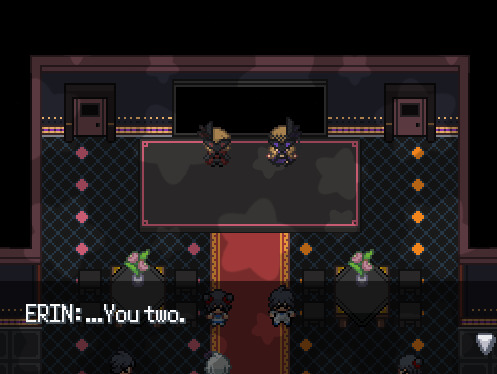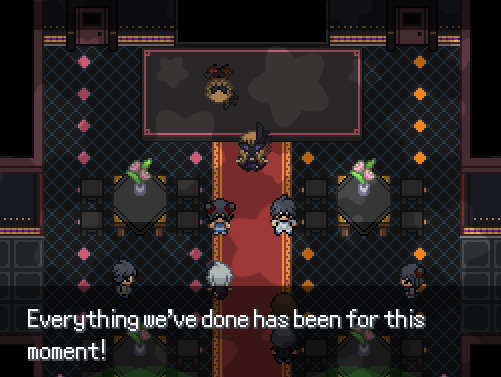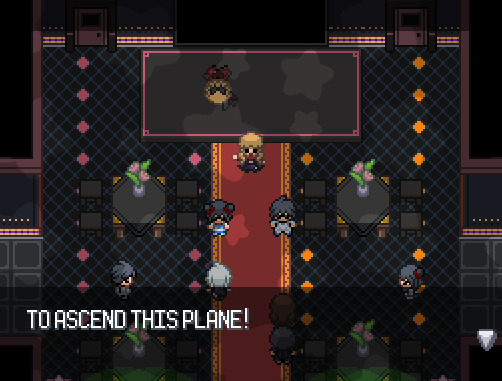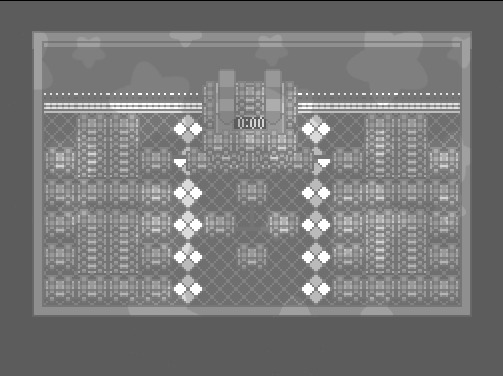#theyre going to blow up the Entire TRI STATE AREA!!!!
Text















holy freaking badass... i knew they were freaky but this is NEXT LEVEL STUFFFF!!!!!!!!!!!!!!!!!!!!!!!!!!!!!!!!!!!!!!!!
#jazzrejuv#im SEATED RIGHT NOWWWW#im also so interested as to what alice and allen know abt erin [and also why allen just fell over ToT?!?]#bc their callin her erina or whatever the hell#and shes reacting in a way where like its not Inaccurate just Uncomfortable. right#so like#gesutres are the screen#wahts their problem!!!#theyre going to blow up the Entire TRI STATE AREA!!!!#and i SUPPORT THEM!!#i wonder if their working with flora or if theyre just like may as well make good of the opportunity#ahhhhhh#AHHHH!!
6 notes
·
View notes
Note
hey! so ive been missing streams 😭 and i was wondering wtf has been happening in the dream smp since the election results were revealed? i'm so lost and i really dont wanna watch all the streams 😔😔😔
oh god a loooot has happened; i personally recommend watching wilburs edited vids on his channel if u rlly want to understand everything but ill give a basic summary!!
major MAJOR spoilers for the dream smp (obviously) so if u don't want to hear about it then don't continue on (also its kinda long bcause all i think about is the dream smp-)
SO schlatt and quackity won the election, schlatt banished wilbur & tommy from l’manberg & renamed l’manberg to manberg. wilbur and tommy created a new place called pogtopia which is a bit away from the manberg / main area. quackity is schlatts vice president, tubbo is secretary of state (i believe?)
tubbo is a spy and is secretly working for pogtopia. technoblade joins the server and joins pogtopia to help take down schlatt. all he did for the most part was farm potatoes...and breed horses....
dream reveals he doesnt support schlatt out of fear that schlatt will begin to take over the entierty of the dream smp, but he cant show his support of pogtopia publicly. niki doesnt like schlatt, schlatt taxes her, they just hate each other in general. fundy is also secretly a spy, but hes not directly giving info to anyone, he just keeps a journal about what he has learned. fundy begins to question what side he supports, and begins to lean more in favor of schlatt because schlatt has been cleaning up the area and basically has been making everything look nice.
tommy and tubbo make a giant tunnel under manberg that leads to pogtopia (which is also connect to the prime path for, well, obvious reasons). technoblade has mostly just been trying to get the best gear for himself & has been trying to breed the best horse (he gets a trident at one point).
wilbur goes insane and believes he and tommy are on the bad side of history, that they’re the villians. wilbur gives up on getting l’manberg back and has settled on just blowing it all to shit so no one can have it. dream backs wilburs plan and supplies him with TNT and wilbur rigs the entire underground of manberg with TNT (much like dream did in l’manberg during the dream smp war) tommy doesnt support wilburs decision to blow everything up.
(this isnt exactly really story-related but sapnap killed tommys cow, henry, and dream, techno, and tommy teamed up to fight sapnap and a few others. idk it isnt rlly important to the plot but i enjoyed it so :D)
schlatt announces there will be a manberg festival, in celebration of democracy and everything. wilbur decides thats the day hes going to blow everything up. tommy still doesnt support wilburs plan. tubbo and fundy (and i think quackity?? idk) set up for the festival. tubbo has a speech written for the festival and one of the lines is the cue for wilbur to press the button to blow everything up.
the day of the festival comes along, schlatt gives a few speeches, wilbur and tommy watch from the top of one of the buildings. everyone is invited (even technoblade) to the festival, except wilbur and tommy. technoblade brings and OP rocket launcher crossbow and tries to get info on manberg. they play games and stuff.
wilbur starts to question if he really wants to go through with blowing everything up (because he will be blowing up all his friends in the process) and tommy continues to try to talk him down. wilbur ends up asking tubbo what he should do, and tubbo doesnt know. wilbur tells tubbo that if he says the cue in the speech, he’ll do it, and if he doesn’t, he wont. tubbos speech comes along eventually, and at the end he hesitates saying the cue, and schlatt begins to ask if he had anything more to say. tubbo eventually does say the cue, and wilbur goes and runs off to find the button to blow everything up.
schlatt starts encasing tubbo in a box and wilbur gets distracted and goes back to see what is going on. schlatt announces infront of everyone that tubbo is a traitor. schlatt calls technoblade up to the stage and tells technoblade to “take him out”. technoblade tries to stall, wilbur and tommy assure tubbo that techno is on their side and wont hurt him. techno gives in to peer pressure and kills tubbo with the rocket launcher crossbow, killing schlatt and quackity in the process (because they were on stage as well and just vacinity stuff yknow).
tommy and wilbur panic. wilbur goes and rushes to find the button, but cant find it. tommy reveals his position and goes in to kill techno, claiming techno has betrayed them. techno just starts shooting his rocket launcher into the crowd, killing basically everyone. tommy and tubbo meet up in the manberg-pogtopia tunnel. wilbur, tommy, tubbo, and techno all go back to pogtopia. wilbur and tommy are the most mad at techno, but wilbur forgives him. tommy doesnt and still believes hes a traitor. wilbur manipulates tommy and tells him to use that anger and to kill techno, so they fight in a pit that wilbur made. tommy dies, and everything is basically settled (though tommy is still mad at techno). niki also joins pogtopia. niki, tubbo, and tommy meet up just outside pogtopia and discuss whats going on. they all agree that wilbur has lost his mind and that they can only trust each other, and they begin to discuss plans of building up pogtopia so they can fight back to reclaim l’manberg. sentimental bit of them three looking off into the sunset as tommy plays the original blocks disc.
schlatt doesnt really care what happened, him, quackity, fundy, and a few others continue to play games after the whole techno thing. (i believe something with antfrost, bbh, and awesamdude happened? i dont quite know because i havent watched their pov yet but i believe they formed some kind of alliance to fight against schlatt? correct me if im wrong-) schlatt starts talking about his plans for manberg. he plans to replace the hto dog van with an apartment complex. fundy, quackity, bbh, antfrost, and awesamdude try to talk him down from it. they eventually come to an agreement that the appartment building will be built around it, so you cant see it. schlatt kills a few cats for no real reason. schlatt talks about how he wants to remove the white house (the one quackity built with wilbur and such), quackity gets defensive and tells him not to destroy it as it is a symbol of peace and he worked hard on it. schlatt still wants it to be removed but they plan to discuss it at a later time. fundy is left alone, he questions which side he supports. he is now more in favor of wilburs side because of the public execution of tubbo and the fact he killed cats.
day after the festival quackity and schlatt are on, tommy eventually joins as well. tommy plans to JFK schlatt and goes over to manberg to do so. he watches quackity and schlatt from a far, who are both at the white house. theyre both arguing over whether the white house should stay or go. schlatt wants it gone, quackity doesnt. tommy doesnt make a move and continues to watch. schlatt begins to insult the white house and starts to take it down. quackity gets pissed and kills schlatt and claims that he is no longer a part of manberg and proceeds to run off into the forest. schlatt then continues to demolish the rest of the white house.
tommy goes after quackity; quackity joins pogtopia and they head off to pogtopia. wilbur gets on and claims he has found where the button is and that he doesnt care if no one else is on, all he wants to do is kill schlatt and blow everything up. tommy tells wilbur quackity has now joined them. quackity and tommy then proceed to build a giant dick infront of the manberg flag.
wilbur then goes and shows quackity and tommy the button, quackity finds out about wilburs plan as a result. wilbur tries to push the button multiple times and quackity and tommy try to talk him down from pressing it. quackity says the only reason he ran against wilbur was to prevent dictatorship. they continue to attempt to stop wilbur from pressing the button. tommy at one point stands infront of the button and wilbur tells him to move to the side if he trusts him. tommy hesitates, but then moved. wilbur then destroys the button. wilbur says that now tommy will be leading them and making the next move. before returning to pogtopia to discuss the new plan, wilbur asks for quackity and tommy to wait outside. theres a sad moment and wilbur sings the l’manberg anthem and places the button back and says its just incase, as a backup, just so he knows that if something goes wrong, he can always rely on the button.
the three head back to pogtopia and discuss a plan. im going to be honest i was v lost on what they were saying when discussing the plans because they were all talking at once basically but the first plan, named plan a, is to use quackity to get to schlatt (its named plan a because ass...), then the second plan, plan 1, is yet to be determined, and the last plan, if those two fail, is plan b, which is to go with wilburs original plan of blowing everything to shit (b because bomb haha)
YEA thats the basic summary i think? theres a lot of other details like the fact that fundy, tubbo, and sapnap are now dreamon hunters but !! yea. sorry for this being so long aaaaaaa
20 notes
·
View notes
Link
After a century and a half, the American department store appears to be headed toward the grave. These glittering emporia that once drew crowds with fashion shows, concerts, and lavish holiday windows are going out with whimper, not a bang—an apparent victim of the economic fallout of the coronavirus pandemic.
Department stores had been in declining health for a decade, as they became less relevant in the landscape of American life. There was a time when consumers had to visit these stores to find the latest clothes, shoes, accessories, and home goods from must-know brands, but with the internet, consumers could buy these products from the comfort of their sofas. In a sign of how troubled the industry was, both Barneys and Henri Bendel’s went out of business in 2019. That was before the coronavirus arrived in the United States.
“Yes, department stores have faced troubles in the past, from rationing in the war years to a lack of purchasing power during the Great Depression,” says Vicki Howard, a historian and the author of From Main Street to Mall: The Rise and Fall of the Department Store. “But they’re entering this new crisis in a very weak state, and that could make the outcome worse for them this time around.” In mid-March 2020, department stores were classified as nonessential businesses and forced to shutter in an effort to curb the spread of the disease. This may be the final blow for Neiman Marcus, which is currently contemplating bankruptcy or a fire sale. Analysts at Cowen say that Macy’s, Kohl’s, and J.C. Penney will only be able to withstand a few months of store closures before running out of cash and ending up in the same boat. Nordstrom may have about a year. “These brands are so powerful that they are likely to live on in the wake of COVID-19,” says Howard. “But the department store, as a business model, appears to be at the end of its life.” Their demise hints at an important, if familiar, lesson as retailers consider their future amid rampant uncertainty: innovate or die.
GLITZ AND GLAMOUR
Until the mid-1800s, the best shopping experience a person could buy in the United States was at a “general store,” which sold a wide range of products, from fabric to kitchen supplies. These were the original retailers that didn’t necessarily make products, but curated and sold goods from other merchants, taking a cut of the sale. “These were one-stop shops,” says Chris Calott, an architect and professor of architecture at UC Berkeley. “They offered customers the convenience of not having to go to specialized merchants.”
As money began to flow into major cities across the country, entrepreneurs elevated this concept with stores that curated high-end specialty merchandise. Howard says that department stores began in cities and encapsulated the sophistication and wealth that was emerging in these hubs. “They became ubiquitous urban institutions,” Howard says. “If you lived in a rural area, you would have to travel to a market town, or you’d order products using their mail order catalog.”
Both Macy’s and Lord & Taylor began as small dry goods stores, but in 1858 and 1859 respectively, they opened swanky new stores in Manhattan. In 1875, John Wanamaker launched an eponymous store in Philadelphia, which was quickly followed by Marshall Field’s in Chicago. All of these were modeled on elegant department stores that had popped up in Europe decades before, like Harvey Nichols in London and Bon Marché in Paris. Part of the appeal was that they offered a luxurious experience, with stunning architecture, well-appointed fixtures, and plenty of assistants on hand to help customers.
These early department stores were incredibly innovative. Founders worked hard to make shopping easy and exciting for customers: Wanamaker, for instance, invented the price tag and the return policy. Since department stores purchased merchandise from designers and merchants, they had an incentive to advertise these goods so customers would buy them and they wouldn’t be stuck with so much excess inventory. As a result, department stores got extremely creative with marketing products. They created stunning window displays that artistically showcased products. They staged the very first fashion shows, which became the precursor to the fashion weeks we now have around the world.
Thus began the golden age of retail. Throughout the early 1900s, Americans flocked to these stores to spend their money which, in turn, allowed department stores to invest in more lavish and entertaining in-store experiences. Henri Bendel packaged products in luxurious brown and white striped boxes and became the first American retailer to sell outfits designed by Coco Chanel. In 1914, Lord & Taylor unveiled its Fifth Avenue store, built in the Italian Renaissance style, complete with copper cornices, a limestone palazzo, and a concert hall.
Sure, there were some difficult moments. There was rationing of raw materials during the war years that led to fewer products in stores and a dearth of consumer spending during the Great Depression. But Howard says that the industry was able to bounce back through this period by being creative. “They brought in circus acts and entertainers to drive foot traffic,” she says. “They were able to do things they simply can’t do in this current crisis, since the stores are physically closed.”
THE MALL CHAINS
After World War II, as Americans bought cars and moved into the suburbs, department stores went with them. In the 1960s, developers began creating enormous shopping complexes away from major cities and invited chains like Macy’s, Sears, and Lord & Taylor to become anchor tenants. “Architects wanted to create a town center for fast-growing suburban areas,” says Calott.
There were many reasons for this shift, including a boom in cheap real estate, but there were also darker explanations. “There was a racist component to this,” Howard says. “Cities were increasingly seen as African American. Businesses chose to chase the white market that had fled to the suburbs.”
In some ways, it’s possible to trace the decline of the department store to this expansion into malls. Howard says that mall chains took business away from the original downtown stores, forcing many of them to close. Department store chains developed infrastructure to standardize their mall locations and had warehouses that held massive volumes of inventory, which were shipped across the country. The store fixtures were identical. “They discovered that this kind of centralized organizational structure allowed them to have bigger margins,” she explains. “Mall chains were big business.”
For decades—well into the early 2000s—this strategy worked well. Suburbanites had access to all the same brands that could be found in bigger cities, and many department stores also began offering cheaper products that met the needs of middle-class customers. Cookie-cutter malls weren’t as luxurious as the original department stores, but they could be fun places, with movie theaters, restaurants, and arcades.
But over time, department store mall chains didn’t do enough to evolve in response to changing trends. Many chains had enormous, long-term leases; they didn’t do much to update their stores after opening nor did they invest in creating unique in-store experiences. Buyers at department stores placed enormous orders for products that would be sold across the entire network of stores. This was cost-effective, but it meant they couldn’t take risks on buying interesting pieces that reflected a distinct point of view, so products sold in these stores often felt generic and unoriginal. And at the end of the season, they had to offload a lot of unsold inventory by discounting them, but over time, consumers began to expect these discounts, which forced brands into a race to the bottom for pricing. High-end department stores started to lose their luster.
Most damningly, department stores were slow to adapt to age of e-commerce and social media. When they did eventually launch an online presence, many failed to invest in creating an exciting, easy-to-navigate user experience. These once-glamorous retailers had become dull, sleepy, and generic; meanwhile, online brands were working hard to capture the consumers’ attention. “These large, federated brands didn’t have much to offer the modern customer,” Howard says.
But here’s the thing: It’s clear that before the coronavirus crisis hit, consumers still enjoyed the experience of visiting a store. And some department store chains tried to evolve their formats. Nordstrom, for instance, has experimented with localized, small-format stores. And it is currently in the strongest financial position compared to its peers, according to Cowen. (But according to the New York Times, even Nordstrom is struggling: It is currently canceling orders and putting off paying its vendors.)
Calott, the architect, says that the most successful malls in recent decades have been outdoor ones like Santana Row in San Jose and the newly developed Seaport District in Boston. Both mix together smaller stores with residential and office spaces. But many department stores chains were resistant to shrinking their stores to fit into them.
So where does that leave department stores today? Howard believes that these household names may live on, but in an entirely different format. Brands like Neiman Marcus or Nordstrom may become online-only retailers, for instance. Or they might become something else entirely. Lord & Taylor was recently acquired by Le Tote, a fashion subscription box business. But one thing’s for sure: The age of the enormous, gilded building is over. Consider what has happened to Lord & Taylor’s iconic buildings: They’ve recently been acquired by Amazon and WeWork.
0 notes